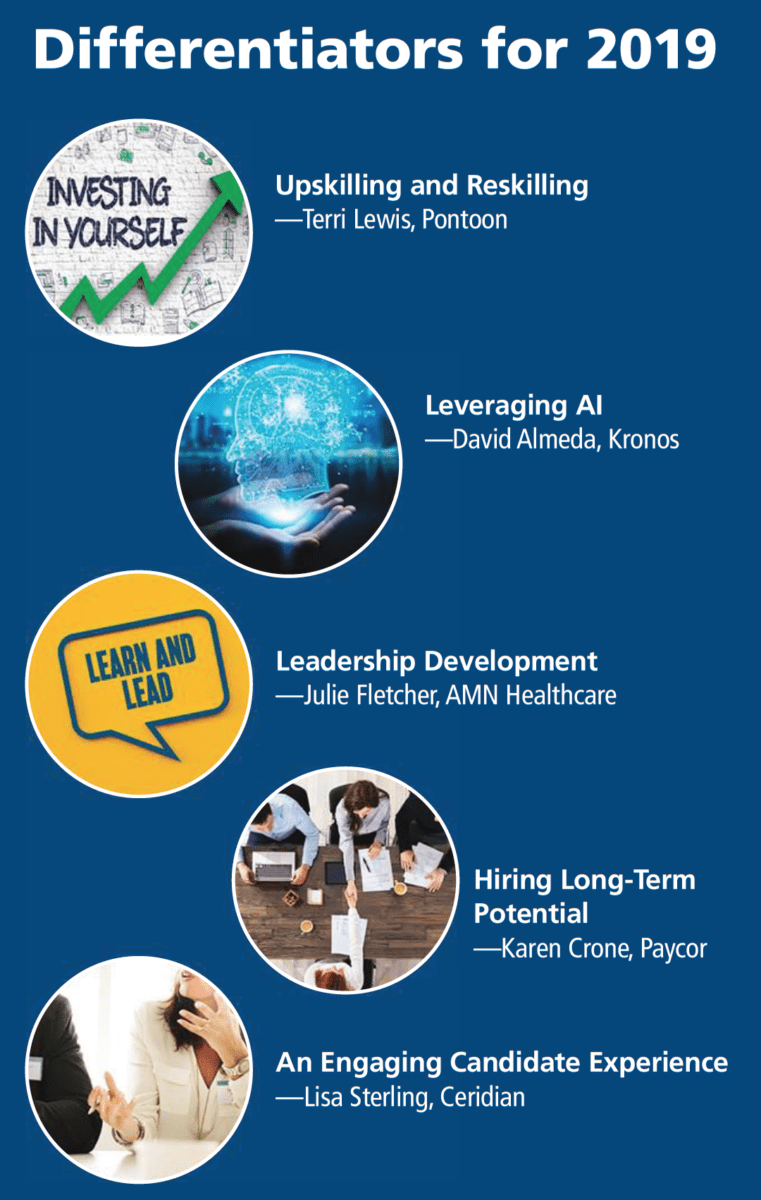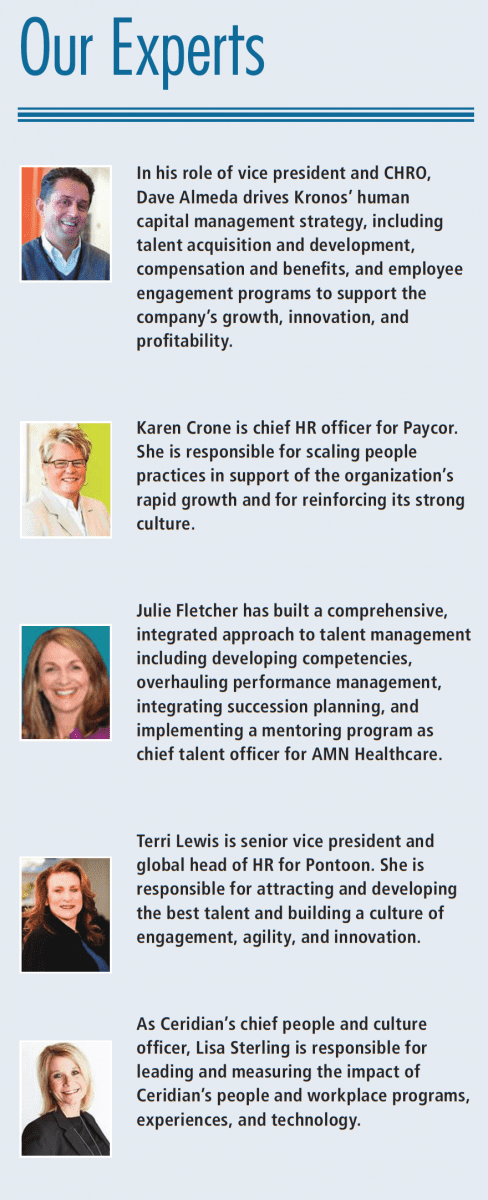What comes with being a CHRO at an HR service partner organization? The answers may surprise you.
By Debbie Bolla
As the CHRO of any organization, running the management of human capital is no easy feat. But imagine the challenges of being an HR leader at an organization whose business is to make HR’s life easier.
“It’s a higher bar in my view,” says Dave Almeda, vice president and CHRO of Kronos, a human capital management and workforce management solutions provider. “How the function performs and how it’s perceived internally here at Kronos matters just like it would if we were running HR at any other company. However, it has a far bigger impact on how the company is perceived externally.”
Almeda says the impact -both positive and negative -is on its customers. A sub-par perception will decrease client expectations just as a favorable one can lead to a approach to the work that we do. Our focus is always on doing the right things to build a great place to work.”
The pressure can also be higher, but Lisa Sterling says it often is self-inflicted. “The challenge of leading the people strategy at an HCM company is that there are higher expectations from the HR team in that we want to be our own best customers,” says the executive vice president and chief people and culture officer for Ceridian, a provider of human resources software. “We are setting the standards for what an excellent workplace culture looks like and must always be forward-thinking and innovative in our approach to be respected industry leaders.”
Karen Crone of Paycor says overseeing HR at a leading provider of human capital management software can drive greater collaboration. “I equate being the CHRO for an HCM service provider to the famous M.C. Escher painting called ‘Drawing Hands,’ where the hands rise from the paper and draw one another,” she explains. “When you lead an organization that is targeted to your role through everyday customer relationships, there’s a deep appreciation and understanding of your organization’s contributions and challenges.”
Crone says that this results in Paycor’s workforce having a greater understanding and appreciation for the organizational goals of HR. “Just today, one of our product managers was presenting on Paycor’s benefits product with ‘open enrollment and life events’ rolling off of his tongue. Paycor employees understand the day-to-day tasks of HR professionals and are motivated to make their jobs easier.”
Terri Lewis, senior vice president and global head of HR for Pontoon, a permanent and contingent workforce solutions provider, agrees. “Jokingly I would tell you everyone thinks they are an HR leader here… more seriously, I would tell you that they really are. This is both a challenge and a benefit,” she explains. “My HR organization is surrounded by a group of leaders who truly care about the future of their teams and believe in driving success with their people. It’s our responsibility to partner with them and provide the right tools to allow them to do so.”
What else comes with being a CHRO at an HR service partner organization? HRO Today had the opportunity to ask these leaders what empowers them at work, how they leverage their clients’ expertise, and what’s on their agenda for 2019.
HRO Today: In your role, do you feel you have extra insight into what is important to the workforce?
Lewis: Our HR team benefits from hearing what is top of minds of the clients we work with. Our team often partners with our client teams to understand their biggest challenges and goals and develop the people strategy to align. We are then able to use that information to frame solutions for our own challenges and goals. I believe that diversity of thought helps drive strong outcomes; through this partnership, we are able to gain many perspectives.

Almeda: Absolutely. We’re exposed to so many points of view that I don’t think other HR functions can easily access. In addition to talking to and hearing from our own workforce, we have the opportunity to collaborate with Kronos customers on a regular basis. Sometimes they’re calling us for advice about a program we’ve initiated, like myTime, our unlimited time-off program. Other times, we’re reaching out to them to discuss trends or best practices.
We also work closely with our product team on product design. We’re able to have direct input into what we’re building, but it also challenges us to think about, for example, the importance of usability and user experience when rolling out changes to programs, processes, and technology. It’s hard for any one person or team to have all the answers. Being able to interact with so many peers globally is hugely beneficial.
HRO Today: In today’s landscape, what makes a difference when attracting and retaining employees?
Lewis: A significant number of current and future employees are interested in more than a paycheck. They want to work for a company whose values they align with. They are interested in understanding that the work they do and the company they work for matter and are driving the future forward. Companies need to consider their real employee value proposition thoughtfully, driving their culture with purpose.
Crone: People go to work to contribute their talents and to grow. When you have an organization that offers job challenge and development opportunities, you attract more than your share of talent. Once you have great people, you retain them through the one-on-one relationships you develop. The foundation of those relationships is an open exchange of ideas, feedback, and interests.
Almeda: We remain focused on being the best possible place to work. Talented people have a choice of where they can work and we want them to choose Kronos. This is an area that gets more competitive every year. If we’re not moving forward, we’re absolutely falling behind.
Sterling: We all know that the demand for top talent is off the charts right now, and depending on skill set, a candidate can be fielding several job offers at any given time, meaning organizations need to stand out for all the right reasons.
The three factors that will really make a difference when trying to attract top talent and retain employees in 2019 are:
- possess and nurture a strong employer brand and culture that not only leadership believes in but is also emulated by all your people;
- effectively tell your story through people who feel passionate about the organization’s values, culture, and brand; and
- provide an engaging candidate experience filled with continuous and transparent communication.
HRO Today: What’s on your agenda for 2019?
Julie Fletcher, Chief Talent Officer for AMN Healthcare, a healthcare staffing and workforce solutions provider: We have several initiatives kicking off as part of our 2019 HR strategic plan.
- In 2018, we enhanced our flagship leadership program for newly hired/acquired or promoted leaders. This year we will continue developing our leadership team with new tools, resources, and hands-on programs that reinforce our commitment to excellence in leadership.
- To support the growth of our organization, we will evolve our focus on workforce planning with a more predictive and metrics-based approach.
- To support our organization through change, we will be formalizing our change management approach and adopt new tools. This will ensure our leaders are prepared and educated to support their teams.
Lewis: We have done a great job gaining access and real insights from our employee data in 2018. We have been able to use that data to make the successful case for an additional focus on talent development and deployment. We will be adding to our internal talent acquisition expertise as well as training and development in a measurable way that will impact every employee. We feel this is a differentiator in today’s tight labor market. We need to provide the skills and development our employees need to continue forward in their careers so they don’t take those careers elsewhere.

Almeda: We’re taking a deep dive into how we are structured as an HR team. We need to be sure that we are as efficient as possible and that we are aligning our processes against creating consistent and intentional outcomes. This is especially true in areas like candidate and employee experience.
Sterling: We want to continue to break the mold of traditional career paths -paths that are becoming obsolete with the changing expectations of workers today who desire constant career growth and a job that challenges and satisfies them. We want to give our people a culture of learning excellence focused on purpose-driven employee education and experiences that will further grow their skill sets and, ultimately, their careers with us.
It’s also important to us to cultivate our inclusive culture, going beyond just recognizing diversity and instead speaking to our multicultural and increasingly global employees in a way that is meaningful to them.
HRO Today: Any other secrets to share?
Lewis: In today’s global economic market with all-time low unemployment numbers virtually everywhere, organizations need to consider their development approach. Without a focus on upskilling and reskilling, as well as a succession planning and talent deployment strategy, it will become very difficult to drive an organization forward.
Almeda: There’s a lot of excitement -and hype -around artificial intelligence and machine learning. It will be really interesting to watch where these technologies take HR in 2019 and 2020. At Kronos, our HR team is still carefully evaluating how they could be used to augment and further improve our efforts to build a high-performing culture. For me, and likely other CHROs, it will be important to see specific use cases that deliver measurable improvements. Kronos calls “practical AI” a way to solve common, time-consuming, everyday operational challenges, like improved labor forecasting to build better schedules, time-off requests processed in real time, and shift-swapping between staff without any manager involvement. This solves a real problem of unburdening managers from routine administrative work while empowering employees (especially in the hourly workforce) to have more control of their schedule. It will be interesting to see where the AI takes the overall market, and where the market sees the best, most beneficial use cases for AI.














